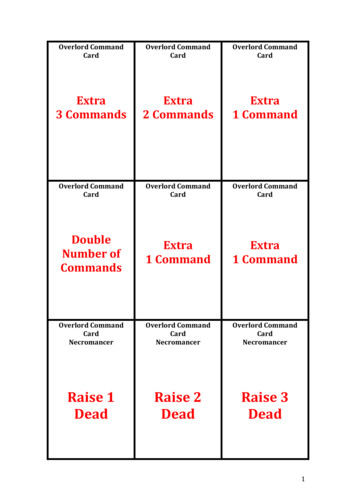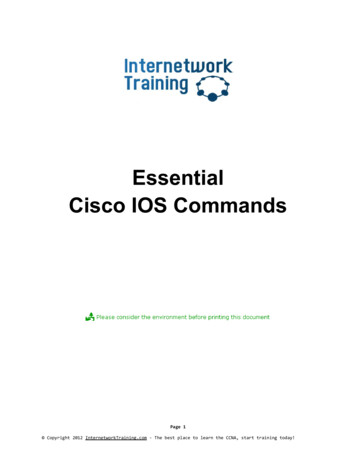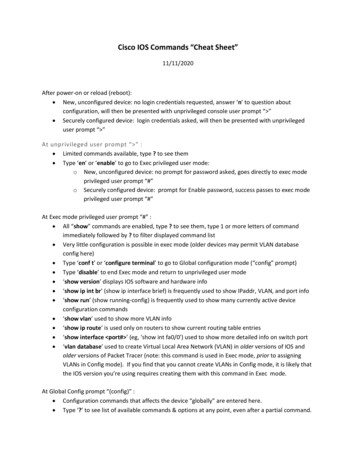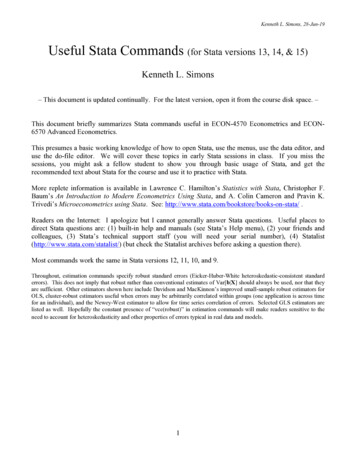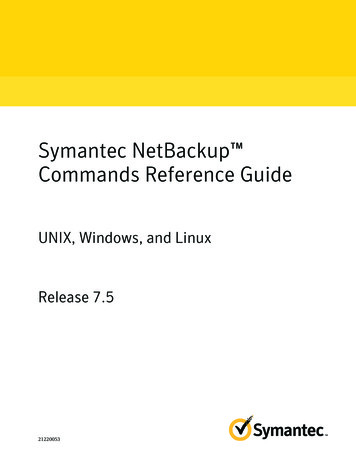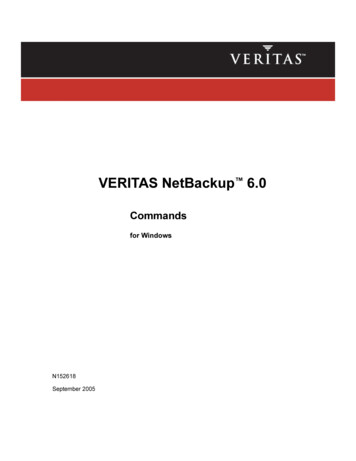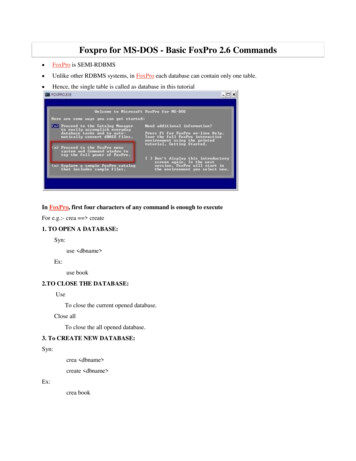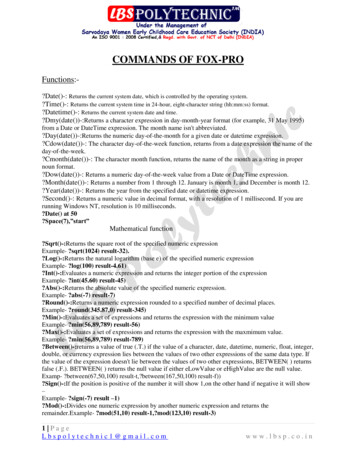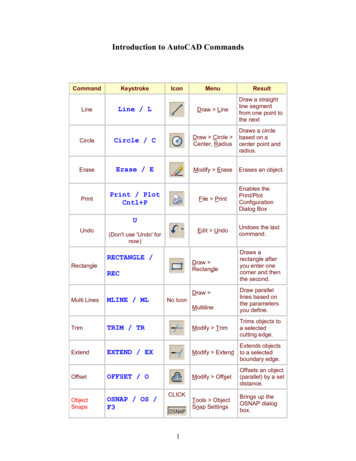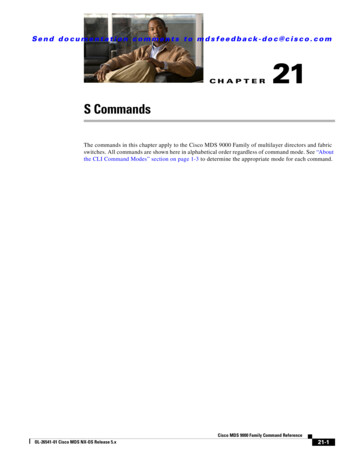
Transcription
Se n d d o c u m e n t a t i o n c o m m e n t s t o m d s f e e d b a ck - d o c @ c i s c o . c o mCH A P T E R21S CommandsThe commands in this chapter apply to the Cisco MDS 9000 Family of multilayer directors and fabricswitches. All commands are shown here in alphabetical order regardless of command mode. See “Aboutthe CLI Command Modes” section on page 1-3 to determine the appropriate mode for each command.Cisco MDS 9000 Family Command ReferenceOL-26541-01 Cisco MDS NX-OS Release 5.x21-1
Chapter 21S Commandssalt (sa configuration submode)Se n d d o c u m e n t a t i o n c o m m e n t s t o m d s f e e d b a ck - d o c @ c i s c o . c o msalt (sa configuration submode)To configure the salt for the Security Association (SA), use the key command. To delete the salt fromthe SA, use the no form of the command.salt saltno salt saltSyntax DescriptionsaltDefaultsNone.Command ModesConfiguration submodeCommand HistoryReleaseModificationNX-OS 4.2(1)This command was introduced.Specifies the salt for encryption. The range is from 0x0 to 0xffffffff.Usage GuidelinesNone.ExamplesThe following example shows how to configure the salt for the current SA:switch# config tswitch(config)# fcsp esp sa 257This is a Early Field Trial (EFT) feature.on environment. Continue Y/N ? [no] yswitch(config-sa)# salt 0x0Related CommandsPlease do not use this in a productiCommandDescriptionfcsp enableEnables FC-SP.show fcsp interfaceDisplays FC-SP-related information for a specific interface.Cisco MDS 9000 Family Command Reference21-2OL-26541-01 Cisco MDS NX-OS Release 5.x
Chapter 21S Commandssan-ext-tuner enableSe n d d o c u m e n t a t i o n c o m m e n t s t o m d s f e e d b a ck - d o c @ c i s c o . c o msan-ext-tuner enableTo enable the IP Network Simulator to simulate a variety of data network conditions, use thesan-ext-tuner enable command.san-ext-tuner enableSyntax DescriptionThis command has no arguments or keywords.DefaultsNone.Command ModesConfiguration modeCommand HistoryReleaseModification3.1(1)This command was introduced.Usage GuidelinesThe IP Network Simulator tool is used for network simulation and is supported on the 8-port IP StorageServices (IPS-8) module and 4-port IP Storage Services (IPS-4) module only. You must also have eitherthe SAN extension over IP package for IPS-8 modules (SAN EXTN OVER IP) or SAN extension overIP package for IPS-4 modules (SAN EXTN OVER IP IPS4), so that you can enable the SANExtension Tuner, a prerequisite for enabling and using the network simulator.You must have a pair of Gigabit Ethernet ports dedicated for each Ethernet path requiring simulation;these ports cannot provide FCIP or iSCSI functionality while simulation occurs. The remaining portsthat are not performing network simulations can run FCIP or iSCSI. Ports dedicated to networksimulation must be adjacent, and always begin with an odd-numbered port. For example, GE 1/1 and GE1/2 would be a valid pair, while GE 2/2 and GE 2/3 would not.NoteExamplesThis command is not supported on the Cisco MDS 9124 switch, the Cisco Fabric Switch for HPc-Class BladeSystem, and the Cisco Fabric Switch for IBM BladeCenter.The following example shows how to enable the SAN Extension Tuner and enable a pair of ports fornetwork simulation:switch# config tswitch(config)#switch(config)# san-ext-tuner enableswitch(config)# exitswitch#switch# ips netsim enable interface gigabitethernet 2/3 gigabitethernet 2/4Cisco MDS 9000 Family Command ReferenceOL-26541-01 Cisco MDS NX-OS Release 5.x21-3
Chapter 21S Commandssan-ext-tuner enableSe n d d o c u m e n t a t i o n c o m m e n t s t o m d s f e e d b a ck - d o c @ c i s c o . c o mRelated CommandsCommandDescriptionshow ips netsimDisplays a summary of the interfaces that are currently operating innetwork simulation mode.show ips statsnetsim ingressDisplays the parameters and statistics of interfaces currently operating innetwork simulation mode for the specified direction of traffic.Cisco MDS 9000 Family Command Reference21-4OL-26541-01 Cisco MDS NX-OS Release 5.x
Chapter 21S Commandssantap moduleSe n d d o c u m e n t a t i o n c o m m e n t s t o m d s f e e d b a ck - d o c @ c i s c o . c o msantap moduleTo configure the mapping between the Storage Services Module (SSM) and the VSAN where theappliance is configured, use the santap module command in configuration mode. To disable this feature,use the no form of the command.santap module slot-number {appl-vsan vsan-id [cvt-name cvt-name] dvt target-pwwn target-pwwn target-vsan target-vsan-id dvt-name dvt-name dvt-vsandvt-vsan-id [dvt-port port-number] [lun-size-handling enable/disable] [io-timeouttimeout-value]}no santap module slot-number {appl-vsan vsan-id [cvt-name cvt-name] dvt target-pwwn target-pwwn}Syntax DescriptionDefaultsslot-numberSpecifies the slot number of the SSM where the control virtual target (CVT) iscreated.appl-vsan vsan-idSpecifies the appliance VSAN identification number used to communicatewith the appliance. The range is 1 to 4093.cvt-name cvt-name(Optional) Specifies the control virtual target (CVT) name. The maximumsize is 80 characters.dvtConfigures the data virtual target (DVT).target-pwwntarget-pwwnSpecifies the target pWWN for the DVT. The format dSpecifies the target VSAN for the DVT. The range for the real target-vsan-idis 1 through 4093.dvt-name dvt-nameSpecifies the DVT name. The maximum size is 80 characters.dvt-vsan dvt-vsan-idSpecifies the DVT VSAN. The range for the dvt-vsan-id is 1 through 4093.dvt-port port-number(Optional) Specifies the DVT port. The range for the port number is 1through 32.lun-size-handlingenable/disable(Optional) Enables or disables LUN size handling. Specify 1 to enable or 0to disable LUN size handling, with the default being enable.io-timeouttimeout-value(Optional) Specifies the I/O timeout value. The range is 10 to 200 seconds,with the default being 10 seconds.Disabled.The IO-timeout is 10 seconds.Lun-size-handling is Enabled.Command Modesonfiguration mode.Cisco MDS 9000 Family Command ReferenceOL-26541-01 Cisco MDS NX-OS Release 5.x21-5
Chapter 21S Commandssantap moduleSe n d d o c u m e n t a t i o n c o m m e n t s t o m d s f e e d b a ck - d o c @ c i s c o . c o mCommand HistoryUsage GuidelinesReleaseModification2.1(1a)This command was introduced.3.0(1)Added the following options: cvt-name, dvt, target-pwwn, target-vsan,dvt-name, dvt-vsan, dvt-port, lun-size-handling, and io-timeout.To access this command, you must first enable the SANTap feature on the SSM using the ssm enablefeature command.When the lun-size-handling option is set (enabled), the maximum logical block addressing (LBA) forDVT LUN is set to 2 TB. As a result, there is no issue with LUN resizing.NoteExamplesYou can delete dvt target-pwwn using the no santap module slot dvt target-pwwn command. Other dvtoptions are not supported by the no form of the command.The following example shows the configuration of the SSM where the SANTap feature is enabled andthe VSAN used to communicate with the appliance:switch# config terminalEnter configuration commands, one per line. End with CNTL/Z.switch(config)# santap module 1 appl-vsan 1Related CommandsCommandDescriptionshow santap moduleDisplays the configuration and statistics of the SANTap feature.ssm enable featureEnables the SANTap feature on the SSM.Cisco MDS 9000 Family Command Reference21-6OL-26541-01 Cisco MDS NX-OS Release 5.x
Chapter 21S Commandsscaling batch enableSe n d d o c u m e n t a t i o n c o m m e n t s t o m d s f e e d b a ck - d o c @ c i s c o . c o mscaling batch enableTo enable scalability in the Cisco SME configuration, use the scaling batch enable command. To disablethis feature, use the no form of the command.scaling batch enableno scaling batch enableSyntax DescriptionThis command has no arguments or keywords.DefaultsNone.Command ModesCisco SME cluster onfiguration submodeCommand HistoryReleaseModificationNX-OS 4.1(3)This command was introduced.Usage GuidelinesNone.ExamplesThe following example shows how to enable Cisco SME scalability:switch# config tswitch(config)# sme cluster c1switch(config-sme-cl)# scaling batch enableswitch(config-sme-cl)#Related CommandsCommandDescriptionshow santap moduleDisplays the configuration and statistics of the SANTap feature.ssm enable featureEnables the SANTap feature on the SSM.Cisco MDS 9000 Family Command ReferenceOL-26541-01 Cisco MDS NX-OS Release 5.x21-7
Chapter 21S CommandsschedulerSe n d d o c u m e n t a t i o n c o m m e n t s t o m d s f e e d b a ck - d o c @ c i s c o . c o mschedulerTo schedule a maintenance job, use the scheduler command. To disable a job, use the no form of thecommand.scheduler {aaa-authentication [username username] password [0 7] password job namejob-name logfile size filesize schedule name schedule-name}no scheduler {aaa-authentication [username username] password [0 7] password job namejob-name logfile size filesize schedule name schedule-name}Syntax Descriptionaaa-authenticationSpecifies AAA credentials for AAA authentication of a remote user.username(Optional) Specifies the remote user and specifies the username. If the usernamekeyword is not specified in the command, the currently logged-in user's namewill be used.username(Optional) Specifies the remote user username.passwordSpecifies the password of the logged-in remote user for AAA authentication.0(Optional) Specifies that the password is in clear text.7(Optional) Specifies that the password is encrypted.passwordSpecifies the remote user’s password. If the encryption level was notspecified (0 or 7), the supplied password will be encrypted.job nameSpecifies a scheduler job.job-nameSpecifies the name of the scheduler job. The maximum length is 31characters.logfile sizeSpecifies a log file configuration.filesizeSpecifies the size of the log file. The range is 16 to 1024 KB.schedule nameSpecifies a scheduler schedule.schedule-nameSpecifies the name of the schedule. The maximum length is 31 characters.DefaultsNone.Command ModesConfiguration modeCommand HistoryReleaseModificationNX-OS 4.1(3)Deleted a note from the Usage Guidelines.NX-OS 4.1(1b)Added a note to the Usage Guidelines.2.0(x)This command was introduced.Usage GuidelinesScheduler job configurations may not be edited. They need to be deleted and reconfigured to make changes.Jobs may comprise of multiple commands which can be entered in a single line by using ";" as the delimiterbetween commands.Cisco MDS 9000 Family Command Reference21-8OL-26541-01 Cisco MDS NX-OS Release 5.x
Chapter 21S CommandsschedulerSe n d d o c u m e n t a t i o n c o m m e n t s t o m d s f e e d b a ck - d o c @ c i s c o . c o mA user's credentials are checked by the scheduler before allowing them to create, delete or run a scheduledjobs. Use the scheduler aaa-authetication command to configure a remote user's (a user without local credentials) credentials. The scheduler uses these credentials to verify that the user account is still active on theAAA server each time before it starts the job.To use the command scheduler. You do not need to obtain any license.ExamplesThe following example shows how to enable the scheduler command:switch# config tswitch(config)# feature schedulerswitch(config)#The following example shows how to specify the password for the currently logged-in remote user:switch# config tswitch(config)# scheduler aaa-authentication password newpwdswitch(config)#The following example shows how to specify a clear text password for the currently logged-in remoteuser:switch# config tswitch(config)# scheduler aaa-authentication password 0 X12y34Z56aswitch(config)#The following example shows how to specify a name and password for a remote user:switch# config tswitch(config)# scheduler aaa-authentication username newuser password newpwd3switch(config)#The following example shows how to specify scheduler logfile size:switch(config)# scheduler logfile size 512switch(config)#The following example shows how to define a name for the schedule and enters the submode for thatschedule:switch(config)# scheduler schedule name my timetableswitch(config-schedule)#The following example shows how to specify a schedule to run jobs:switch(config-schedule)# time daily 1:23switch(config-schedule)#The following example shows how to define a job that uses variables:switch(config)# scheduler job name my jobswitch(config-job)# cli var name timestamp (TIMESTAMP);copy running-configbootflash:/ (SWITCHNAME)-cfg. (timestamp);copy bootflash:/ (SWITCHNAME)-cfg. (timestamp)tftp://1.2.3.4/switch(config-job)# exitswitch(config)#Cisco MDS 9000 Family Command ReferenceOL-26541-01 Cisco MDS NX-OS Release 5.x21-9
Chapter 21S CommandsschedulerSe n d d o c u m e n t a t i o n c o m m e n t s t o m d s f e e d b a ck - d o c @ c i s c o . c o mRelated CommandsCommandDescriptioncli varDefines a variable.feature schedulerEnables the scheduler.job nameSpecifies a scheduler job.show scheduler timeDisplays scheduler information.timeSpecifies a schedule start time.Cisco MDS 9000 Family Command Reference21-10OL-26541-01 Cisco MDS NX-OS Release 5.x
Chapter 21S Commandsscsi-flow distributeSe n d d o c u m e n t a t i o n c o m m e n t s t o m d s f e e d b a ck - d o c @ c i s c o . c o mscsi-flow distributeTo enable SCSI flow distribution through CFS, use the scsi-flow distribute command. To disable theSCSI flow distribution, use the no form of the command.scsi-flow distributeno scsi-flow distributeSyntax DescriptionThis command has no arguments or keywords.DefaultsSCSI flow distribution is enabled.Command ModesConfiguration modeCommand HistoryReleaseModification2.0(2)This command was introduced.Usage GuidelinesYou must enable the SCSI flow feature on the Storage Services Module (SSM) before you can configurean SCSI flow. Use the ssm enable feature module slot-number command to enable the SCSI flowfeature on the SSM.ExamplesThe following example enables distribution of SCSI flow services using CFS:switch# config terminalEnter configuration commands, one per line.switch(config)# scsi-flow distributeEnd with CNTL/Z.The following example disables distribution of SCSI flow services:switch(config)# no scsi-flow distributeRelated CommandsCommandDescriptionshow santap moduleDisplays SCSI flow configuration and status.ssm enable featureEnables the SCSI flow feature on the SSM.Cisco MDS 9000 Family Command ReferenceOL-26541-01 Cisco MDS NX-OS Release 5.x21-11
Chapter 21S Commandsscsi-flow flow-idSe n d d o c u m e n t a t i o n c o m m e n t s t o m d s f e e d b a ck - d o c @ c i s c o . c o mscsi-flow flow-idTo configure SCSI flow services, use the scsi-flow flow-id command. To disable the SCSI flow services,use the no form of the command.scsi-flow flow-id flow-id {initiator-vsan vsan-id initiator-pwwn wwn target-vsan vsan-idtarget-pwwn wwn statistics write-acceleration [buffers count]}no scsi-flow flow-id flow-id {statistics write-acceleration]Syntax Descriptionflow-idConfigures the SCSI flow identification number. The range is 1 to 65535.initiator-vsan vsan-idSpecifies the initiator VSAN identification number. The range is 1 to 4093.initiator-pwwn wwnConfigures initiator side pWWN.target-vsan vsan-idConfigures target VSAN identification number of the SCSI flow.target-pwwn wwnConfigures the target side pWWN.statisticsEnables statistics gathering.write-accelerationEnables write acceleration.buffers count(Optional) Configures the write acceleration buffer count. The range is 1 to40000 and the default is 1024.DefaultsSCSI flow services are disabled.Command ModesConfiguration modeCommand HistoryReleaseModification2.0(2)This command was introduced.Usage GuidelinesYou must enable the SCSI flow feature on the Storage Services Module (SSM) before you can configurea SCSI flow. Use the ssm enable feature module slot-number command to enable the SCSI flow featureon the SSM.ExamplesThe following example configures an SCSI flow with a flow identifier of 4 and the following attributes: Initiator VSAN number—101 Initiator port WWN—21:00:00:e0:8b:05:76:28 Target VSAN number—101 Target port—WWN 21:00:00:20:37:38:67:cfswitch# config terminalswitch(config)# scsi-flow flow-id 4 initiator-vsan 101 initiator-pwwn21:00:00:e0:8b:05:76:28 target-vsan 101 target-pwwn 21:00:00:20:37:38:67:cfCisco MDS 9000 Family Command Reference21-12OL-26541-01 Cisco MDS NX-OS Release 5.x
Chapter 21S Commandsscsi-flow flow-idSe n d d o c u m e n t a t i o n c o m m e n t s t o m d s f e e d b a ck - d o c @ c i s c o . c o mThe following example disables a SCSI flow with a flow identifier of 4:switch(config)# no scsi-flow flow-id 4The following example configures SCSI flow 4 to gather statistics about the SCSI flow:switch(conf)# scsi-flow flow-id 4 statisticsThe following example disables the statistics gathering feature on SCSI flow 4:switch(conf)# no scsi-flow flow-id 4 statisticsThe following example configures SCSI flow 4 with write acceleration:switch(conf)# scsi-flow flow-id 4 write-accelerationThe following example configures SCSI flow 4 with write acceleration and buffers of 1024 credits:switch(conf)# scsi-flow flow-id 4 write-acceleration buffer 1024The following example disables the write acceleration feature on SCSI flow 4:switch(conf)# no scsi-flow flow-id 4 write-accelerationRelated CommandsCommandDescriptionshow scsi-flowDisplays SCSI flow configuration and status.ssm enable featureEnables the SCSI flow feature on the SSM.Cisco MDS 9000 Family Command ReferenceOL-26541-01 Cisco MDS NX-OS Release 5.x21-13
Chapter 21S Commandsscsi-targetSe n d d o c u m e n t a t i o n c o m m e n t s t o m d s f e e d b a ck - d o c @ c i s c o . c o mscsi-targetTo configure SCSI target discovery, use the scsi-target command in configuration mode. To removeSCSI target discovery, use the no form of the command.scsi-target {auto-poll [vsan vsan-id] discovery ns-poll [vsan vsan-id] on-demand [vsanvsan-id]}no scsi-target {auto-poll [vsan vsan-id] discovery ns-poll [vsan vsan-id] on-demand [vsanvsan-id]}Syntax Descriptionauto-pollConfigures SCSI target auto polling globally or per VSAN.vsan vsan-id(Optional) Specifies a VSAN ID. The range is 1 to 4093.discoveryConfigures SCSI target discovery.ns-pollConfigures SCSI target name server polling globally or per VSAN.on-demandConfigures SCSI targets on demand globally or per VSAN.DefaultsSCSI target discovery for each option is on.Command ModesConfiguration modeCommand HistoryReleaseModification3.0(1a)This command was introduced.Usage GuidelinesAutomatic global SCSI target discovery is on by default. Discovery can also be triggered for specificVSANs using on-demand, name server polling, or auto-polling options. All options are on by default.Use the no scsi-target discovery command to turn off all discovery options. You can also turn offspecific options by using the no form of the command.ExamplesThe following example configures SCSI target auto-polling discovery for VSAN 1:switch# config tswitch(config)# scsi-target auto-poll vsan 1The following example removes SCSI target auto-polling discovery for VSAN 1:switch# config tswitch(config)# no scsi-target auto-poll vsan 1The following example configures an SCSI target discovery:switch# config tswitch(config)# scsi-target discoveryThe following example removes a SCSI target discovery:Cisco MDS 9000 Family Command Reference21-14OL-26541-01 Cisco MDS NX-OS Release 5.x
Chapter 21S Commandsscsi-targetSe n d d o c u m e n t a t i o n c o m m e n t s t o m d s f e e d b a ck - d o c @ c i s c o . c o mswitch# config tswitch(config)# no scsi-target discoveryThe following example configures SCSI target ns-polling discovery for VSAN 1:switch# config tswitch(config)# scsi-target ns-poll vsan 1The following example removes SCSI target ns-polling discovery for VSAN 1:switch# config tswitch(config)# no scsi-target ns-poll vsan 1The following example configures SCSI target on-d
Chapter 21 S Commands scheduler A user's credentials are checked by the scheduler before allowing them to create, delete or run a scheduled jobs. Use the scheduler aaa-authetication command to configure a remot
